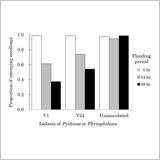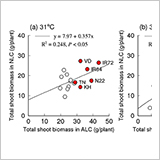Review
Rice Adaptation to Aerobic Soils: Physiological Considerations and Implications for Agronomy
Y. Kato and K. Katsura
- Recent studies on dry-seeded rice on aerobic soil (aerobic rice) were reviewed.
- Attainable yield of aerobic rice is 10-11 t ha-1 under temperate climates.
- Mechanisms on low yield of aerobic rice in the tropics must be unraveled.
- This review revealed important plant characteristics of aerobic adaptation.
Abstract Full Text PDF[2138K] |
 |
Crop Morphology
Morphological Changes and Function of Calcium Oxalate Crystals in Eddo Roots in Hydroponic Solution Containing Calcium at Various Concentrations
M.N. Islam and M. Kawasaki
- Morphological changes and function of calcium oxalate crystals in eddo roots under different concentrations of calcium in hydroponic solution were investigated.
- The crystals in crystal idioblasts were tubularly arranged at the peripheral part in cortex of tip parts of primary roots in eddo.
- The crystals in the tubular arrangement seemed to be concerned in regulation of calcium levels in cortex parenchyma cells in the tip parts of primary roots.
Abstract Full Text PDF[3235K] |
 |
Crop Physiology
Germination, Growth, Chlorophyll Fluorescence and Ionic Balance in Linseed Seedlings Subjected to Saline and Alkaline Stresses
R. Guo, J. Zhou, W.P. Hao, F.X. Gu, Q. Liu, H.R. Li, X. Xia and L.L. Mao
- The physiological responses of linseed seeds and seedlings to saline stress (SS) and alkaline stress (AS) were evaluated.
- The alkaline stress may be mediated through Na+ uptake accumulation to toxic levels, leading to a decrease in photosynthetic pigments and damage to the photosynthetic apparatus.
- Carbohydrates and proline synthesis decreased osmotic potential, remedied the shortage of inorganic anions and maintained stability of the intracellular pH allowing the plant to cope better with osmotic stress from high Na+ vacuolar concentrations.
Abstract Full Text PDF[1143K] |
 |
Salinity Tolerance of Super-Nodulating Soybean Genotype En-b0-1
Y. Yasuta and M. Kokubun
- Under saline conditions, super-nodulating genotype En-b0-1 formed heavier nodules and biomass than its normal-nodulating parental cultivar Enrei.
- Under saline conditions, the concentrations of Na and Cl in shoots in En-b0-1 were significantly lower, while those in roots were higher than in Enrei.
- The super-nodulating genotype En-b0-1 exhibited greater salinity tolerance, due to its superior nodulation and prevention of excessive accumulation of Na and Cl in shoots.
Abstract Full Text PDF[713K] |
 |
QTLs for Seedling Growth of Direct Seeded Rice under Submerged and Low Temperature Conditions
A. Fukuda, T. Kataoka, H. Shiratsuchi, A. Fukushima, H. Yamaguchi, H. Mochida and H. Ogiwara
- QTLs for the germination rate and shoot dry weight were detected on the same chromosomal region.
- Low temperature germinability gene, qLTG3-1, localized near the Lod peaks of the QTLs.
- Functional qLTG3-1 increased germination rates of lines, though Rc declined the germination rates.
Abstract Full Text PDF[934K] |
 |
Genetic Resources Evaluation
Alleles Affecting 30 Traits for Productivity in Two Japonica Rice Varieties, Koshihikari and Nipponbare (Oryza sativa L.)
K. Ujiie and K. Ishimaru
- For 30 traits, we identified 249 chromosome regions affecting traits (CRATs) by Nipponbare alleles.
- Some CRATs represented superior effects as compared with the alleles in two indica varieties.
- A CRAT for panicle number (PN1) improved the yield by a pleiotropic effect on sink and source.
Abstract Full Text PDF[1677K] |
 |
Agronomy & Crop Ecology
Comparison of Five Nitrogen Dressing Methods to Optimize Rice Growth
Q. Chen, Y. Tian, X. Yao, W. Cao and Y. Zhu
- This study compared the effect and applicability of five nitrogen (N) dressing recommendation approaches in rice; canopy spectrum based nitrogen optimization algorithm (CSNOA), leaf area index (LAI), site-specific N management (SSNM), N nutrition index (NNI), and N fertilizer optimization algorithm (NFOA).
- Compared with the standard normal treatment (SN), under the low base-tiller N level, less N rate and higher economic benefit were obtained with the N dressing methods of CSNOA and SSNM, whereas more N rate and lower economic benefit were observed with the other three N dressing approaches.
- The CSNOA and SSNM were two good techniques for quantifying N dressing recommendation in rice, with higher economic benefit, less N input, and better applicability under different base-tiller N levels.
Abstract Full Text PDF[1008K] |
 |
SPAD Values and Nitrogen Nutrition Index for the Evaluation of Rice Nitrogen Status
H. Yang, J. Yang, Y. Lv and J. He
- We determined the SPAD readings of four uppermost fully expanded leaves of two rice cultivars at six N fertilization rates in three growth stages and examined the relationship between SPAD readings and N nutrition index (NNI).
- The lower leaf appeared to be more sensitive than the upper one in response of biomass to N levels, which could be more suitable as a test sample for N status diagnosis by leaf chemical analysis, especially during the booting and heading stage.
- The dependence of grain yield on SPAD readings of the fourth fully expanded leaf (L4) was significant at booting stage: Relative SPAD readings of L4 and NNI demonstrated an even closer relationship with grain yield at booting stage.
Abstract Full Text PDF[1137K] |
 |
Field Evaluation of Coffee Grounds Application for Crop Growth Enhancement, Weed Control, and Soil Improvement
K. Yamane, M. Kono, T. Fukunaga, K. Iwai, R. Sekine, Y. Watanabe and M. Iijima
- The growth inhibitory effects of coffee grounds spontaneously diminished after 12 months later, and the application of horse manure effectively alleviated the inhibitory effects.
- The soil amendment effects by the application of coffee grounds were significantly higher in terms of nitrogen enrichment and CN ratio.
- These results indicated that coffee grounds are useful to enhance long term crop growth, short duration weed control, and soil improvement in agricultural fields.
Abstract Full Text PDF[1096K] |
 |
Varietal Difference in Nitrogen Redistribution from Leaves and Its Contribution to Seed Yield in Soybean
X. Zhao, S.-H. Zheng, Fatichin, A. Suzuki and S. Arima
- About 13.8% to 37.9% of the total nitrogen in the seeds was estimated being redistributed from the leaf tissues among ten cultivars.
- The seed yield was correlated positively with the amount of redistributed nitrogen from leaves but with neither the nitrogen concentration in the leaves at R5 nor the proportion of redistributed nitrogen in the seeds.
- Our results indicated that large nitrogen redistribution does not always contribute to high seed yielding, implying the direct nitrogen uptake during seed filling could be more important factor for high seed yielding depend on the cultivars.
Abstract Full Text PDF[661K] |
 |













